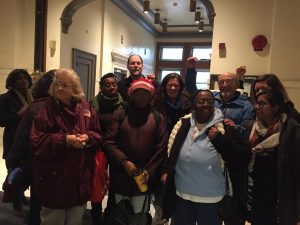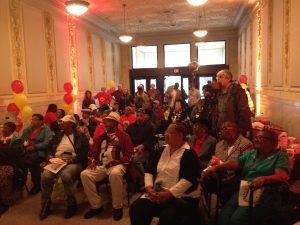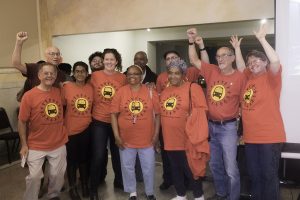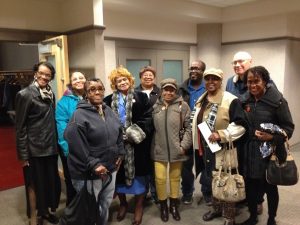Over a dozen speakers from 10 organizations addressed the Port Authority board during their monthly meeting today. The board voted to approve leasing their property at the Castle Shannon T stop for the Shannon Transit Village development.
Post Gazette coverage of the meeting is here: http://www.post-gazette.com/local/city/2016/03/18/Port-Authority-gives-a-go-to-controversial-apartment-development-at-Castle-Shannon-T-stop/stories/201603180208
Trib coverage is here: http://triblive.com/news/allegheny/10170209-74/housing-affordable-residents
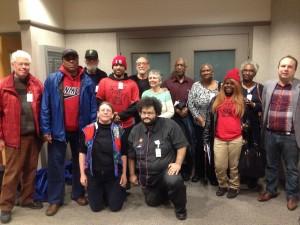
Representatives from PPT, the Thomas Merton Center, the Hill District Consensus Group, the City County Task Force on Disabilities, the Northside Coalition for Fair Housing, the Coalition of Organized Residents in East Liberty, the Penn Hills NAACP, and the Fight for 15 campaign addressed the board on March 18th about the need for inclusive equitable development and, specifically, affordable housing near our transit hubs.
Speakers emphasized the importance of equitable transit oriented development that works to preserve, maintain, and create affordable housing near the best transit service. We understand the Port Authority is currently working on developing transit oriented development (TOD) guidelines—the first of their kind in the state of Pennsylvania. This is excellent news, and we commend the agency for not only developing them but also for including affordable housing as a key principle. We are here today to highlight how important this issue is to many residents in our county and to share why it is crucial for this to be a priority for the agency.
Pittsburghers for Public Transit board chair Jonah McAllister Erickson said, “the agency should develop a policy that requires publicly funded developments at Port Authority stations to include adequate affordable housing and to preserve and maintain affordability in communities.”
We are concerned that TOD, to date, especially in East Liberty, has not been equitable. This publicly funded project includes a development right on the busway with 360 market rate units. Those units should be available to people of all income brackets. Alethia Sims, with the Coalition of Organized Residents, says, “It is unfair that people who need public transportation the most are getting pushed farther away from it. They cannot afford the housing that was just built right next to the East Liberty busway.”
The Shannon Transit Village development at the T stop is using 12 million dollars of public funds (including community development block grants, designed for low-income communities), but it is not adequately serving the public. The development is made up of 152 units of “market rate” housing, which cost $1,150 to $1,800/month. Molly Rush, a resident of Dormont with many family members in Castle Shannon, says, “Who can afford rent that high? The development should be available to all residents of our communities.” The current average rents in Castle Shannon start at $500/month.
“Any publicly funded project in our county must work for all of us,” said Lena Germany, a McDonald’s worker and member of the Pittsburgh Fight for $15. “Creating affordable housing around transit hubs can help level the playing field by providing access to reliable transportation and better paying jobs.”
Full statement from Pittsburghers for Public Transit is here:
My name is Jonah McAllister Erickson, and I’m the Chair of PPT’s coordinating committee. Pittsburghers for Public Transit would like to commend the Port Authority for developing transit oriented development (TOD) guidelines, which we expect to be public in April. These are the first guidelines the Port Authority has ever developed, and the first in Pennsylvania, and the mid-Atlantic region. This is a very significant step and worth noting the hard work of the staff who have developed them. We also want to commend the guidelines for including affordable housing as a fundamental principle for equitable TOD.
We want to add that there should be a policy that requires Port Authority’s TOD to include affordable housing, and to preserve and maintain affordability in communities. The Port Authority—in consultation with the communities, developers, municipalities, authorities, departments—must ensure that adequate affordable housing is near the most frequent and accessible transit service.
To date, development near transit in our region has not included adequate affordable housing. For example, the East Liberty Transit Center. The Eastside Bond apartments, built right along the busway, include 360 units. Not one of them is affordable. Rentals start at 1100 for a studio and go up to 3600 for a 2 bedroom. East Liberty Place South is part of this TOD, but that only includes 61 affordable units. We are pleased to see there is now a fund being set up that is dedicated to affordable housing, but we are concerned that the huge number of units right on the busway, funded through public money, are not open to people of all income brackets. As property values go up in this neighborhood, long-time residents (many of whom are reliant on transit) need to be more protected from displacement.
The residents of Penn Plaza were evicted at the end of February. Some have found new apartments, but many were just temporarily re-located and will have to move again. Where will the residents go? Where will they be able to find housing they can afford? Either places far away with limited transit access? Or places with no transit access? They may be forced to buy a car, which costs thousands and thousands more per year than riding a bus. They may be forced to bum rides, use jitneys, or choose not to take a job or see family or go to church. They could become, in the words of the residents of a transit desert, “prisoners in their own homes.”
Casy Stelitano: PPT wanted to understand how demographic shifts were happening in our region in relation to transit service. Over the last three months we have been working on an Equity Mapping Project, which tracks populations by race, income, access to a vehicle, and cost of housing. We have been focusing on racial demographic shifts, specifically looking at areas in our region that lost and gained significant amounts of African American residents. As a starting point for this research, we’re looking at decennial census data, comparing data from 2000 and 2010. (see maps and chart below)
As we mapped out our data we noticed a very obvious trend. Almost all census tracts that saw a significant decrease in African American residents were located in the city, specifically in the East End and Central Neighborhoods–areas that are walkable, key transit corridors with frequent service (where service comes up to every 12 mins in both directions, 19 hours a day, 7 days a week). Similarly, areas that saw significant increases in African American population were in the county, far away from frequent service and transit hubs. These findings help demonstrate the need for equitable transit oriented development. A lot of the African American residents who are no longer in the city and are now living in the county have limited to no access to decent transportation, which is necessary for them to get to jobs, schools, medical care, art and cultural events, grocery stores, and friends and family. Many residents have come to you and shared personal stories of suffering and hardship due to poor transit in their communities. Port Authority must play a role in making sure that any development near a transit hub includes options for everyone.
The Port Authority is currently involved in three developments along the T in the South Hills, and none of these plans include affordable housing. Today, you will be voting on whether or not to approve a lease of your property at the Castle Shannon T stop. The Shannon Transit Village development will include 152 residential units, and all of them are “market rate.” They cost 1150 to 1800, when the current average rents for Castle Shannon residents is 500-1500 dollars. Any development near the T should not only preserve affordability but also be available to low and moderate income residents. The project is using 12 million dollars, or 28%, of public funding. This includes community development block grants, which are federal grants to benefit low to moderate income communities. We understand the project involves improvement of public infrastructure, but the residential development should also benefit the public and not just those who can afford the market rate.
We need to ensure that the existing infrastructure, especially the busways and the T are accessible to the people who need it the most. Otherwise, it hurts the agency itself. Low-income people are less likely to own cars, so they rely more heavily on transit. When they get pushed out from areas with solid transit service, Port Authority loses ridership. Then the agency has to pay more to provide service out to remote areas. PPT insists that all transit oriented development should be equitable and inclusive, and we want to support the agency in making that happen.
